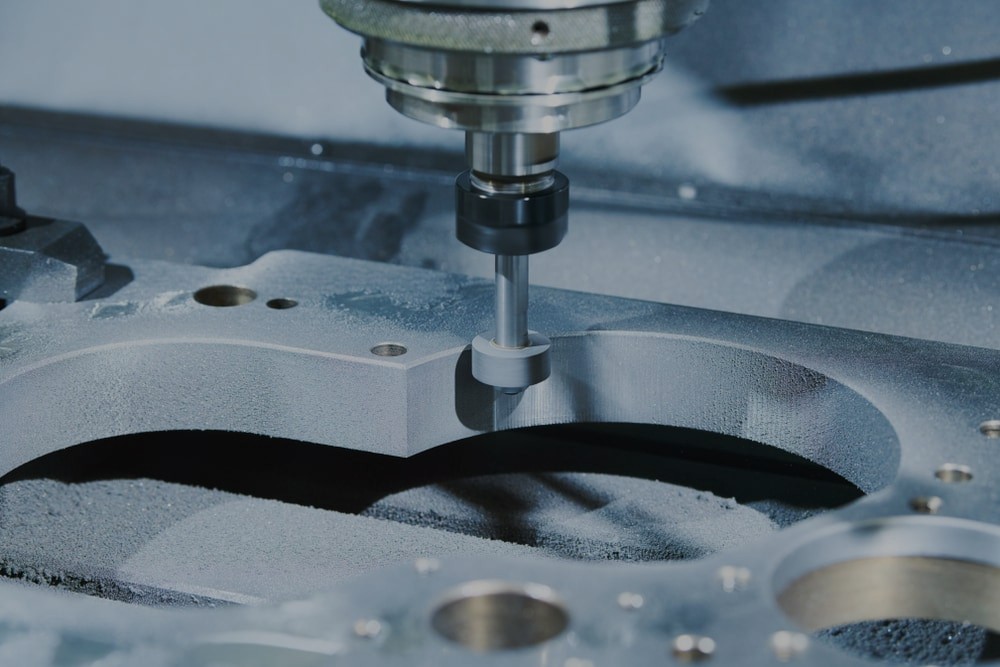

Previously published on fastradius.com on September 29, 2021
Surface finishing is the final step in the CNC machining process, and it’s very important for creating a functional and beautiful CNC machined part. Applying a finish to a CNC machined surface can improve a component’s appearance, remove flaws and excess material, provide additional resistance or strength, and so much more.
There are many different surface finish options for CNC machined parts, from as-machined to anodized to powder coated. In this article, we’ll take an in-depth look at bead blasting, which is one of the more affordable surface finishes available.
The bead blasting process uses a blasting media – beads – under high pressure. Propelling the beads at a surface cleans, polishes, or roughens the surface to the desired finish. These beads are shot out toward the component from a high-pressure bead-blaster. When the beads hit the surface, the impact creates a uniform “dimpling” on the surface. A bead blast finish can clean corroded metal, remove cosmetic defects like textures and contaminants, and prepare a part for paint and other coatings.


You can use steel beads or glass beads for a bead blast surface finish. Steel beads are tough and are often used to clean contaminants and remove unwanted textures from hard metal surfaces. Glass or quartz sand beads are gentler than steel and are the primary type of bead used for bead blasting. This is because glass bead blasting leaves a more smooth, uniform surface finish on a material than steel beads. Glass bead blasting is also more variable because the size of the glass bead changes the quality of the finish it will impart. Fine glass beads leave a “dull” or “satin” smooth finish that’s a cross between a dull and high-gloss finish. Coarse glass beads yield uniform roughness and mask any imperfections.
A bead blast finish leaves your CNC machined part with a smooth, clean, and aesthetically pleasing surface. Bead blasting can be used on a variety of materials — manufacturers can apply bead blasting to hard metals like aluminum, titanium, and stainless steel, as well soft metals like brass or copper, and even plastic.
Here are some other key benefits product teams should keep in mind:
These benefits notwithstanding, glass bead blasting does come with a few drawbacks.
Bead blasting is a flexible, multi-purpose surface finish that involves shooting high-pressure glass or steel beads at a CNC machined component. A bead blast finish can clean your part’s surface and improve the overall appearance, creating a uniform surface with a dull, satin, or rough texture. Bead blasting could even harden a component’s surface and enhance its durability.
If you’re seeking a reliable, eco-friendly, and cost-effective way to give parts a beautiful and consistent surface, consider applying a bead blast finish. At SyBridge, we can help you determine when and where to apply a bead blast finish and pick the type of bead blast surface finish that’s right for your part. Contact us today to learn more.
Forget typical cycle times. We're pushing the boundaries of conformal cooling. While traditional approaches deliver…
Forget typical cycle times. We're pushing the boundaries of conformal cooling. While traditional approaches deliver…
From left to right: Brayden Janak (apprentice); Logan Vifaquain (CNC machining, Programming and CMM); Ron…
SyBridge Technologies is proud to announce we have been awarded the 2023 General Motors Supplier…
Today, designers and engineers are accustomed to working with digital tools in their day-to-day jobs.…
Optimizing Your Injection Molding Process for Cost-Effective Manufacturing Excellence In today’s competitive landscape, manufacturers are…